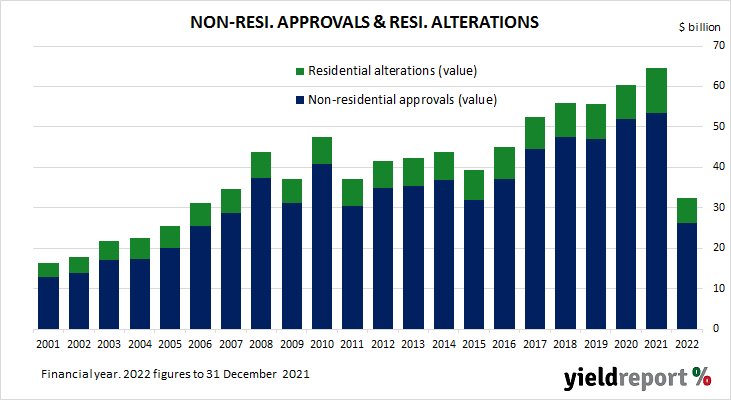Summary: Home approval numbers up 8.2% in December; above 1.0% decline expected; down 7.5% on annual basis; “noise” rather than beginning of sustained lift; higher cash rate later in 2022 will reduce borrowing capacity, could slow activity; house approvals down 1.4%, apartments up 26.7%; non-residential approvals down 16.3% in dollar terms, residential alterations up 5.2% over month.
Building approvals for dwellings, that is apartments and houses, had been heading south since mid-2018. As an indicator of investor confidence, falling approvals had presented a worrying signal, not just for the building sector but for the overall economy. However, approval figures from late-2019 and the early months of 2020 painted a picture of a recovery taking place, even as late as April of that year. Subsequent months’ figures then trended sharply upwards before easing somewhat in the June and September quarters of 2021.
The Australian Bureau of Statistics has released the latest figures from December and total residential approvals increased by 8.2% on a seasonally-adjusted basis. The rise over the month in contrast to the 1.0% decline which had been generally expected and greater than November’s 2.6% increase. However, total approvals fell by 7.5% on an annual basis, slightly higher than the previous month’s revised figure of -8.2%. Monthly growth rates are often volatile.
“Dwelling approvals had a mixed finish to 2021, posting a better than expected 8.2% rise in the final month of the year but with the detail showing softness outside of a narrowly-based rise in ‘units’ that is more likely to be noise than the beginning of a sustained lift,” said Westpac senior economist Matthew Hassan.
Commonwealth Government bond yields fell on the day. By the close of business, the 3-year ACGB yield had lost 2bps to 1.37% while 10-year and 20-year yields each finished 4bps lower at 1.89% and 2.34% respectively.
“The popularity of working from home and low rates are supporting building approvals. A cash rate hike, expected in September 2022, will reduce borrowing capacity and could slow activity, though even after one or more increases in the cash rate, the borrowing environment remains broadly supportive,” said ANZ senior economist Adelaide Timbrell.
Westpac’s Hassan said if one looks through the monthly volatility, “building approvals more generally have seen a sharp turnaround since May…”
Approvals for new houses declined by 1.4% over the month, repeating November’s fall in percentage terms. On a 12-month basis, house approvals were 20.8% lower than they were in December 2020, down from November’s comparable figure of -10.3%.
Apartment approval figures are usually a lot more volatile and December’s total rose by 26.7% after an 11.2% gain in November. The 12-month growth figure improved from November’s revised rate of -3.9% to +23.5%.
Non-residential approvals fell by 16.3% in dollar terms over the month and by 5.2% on an annual basis. Figures in this segment also tend to be rather volatile.
Residential alteration approvals increased by 5.2% in dollar terms over the month and were 9.9% higher than in December 2020.



